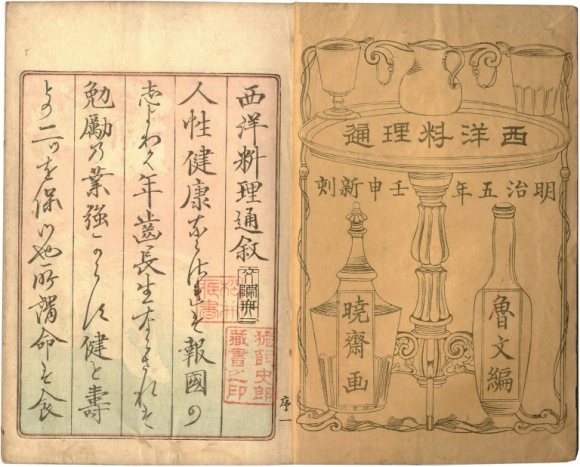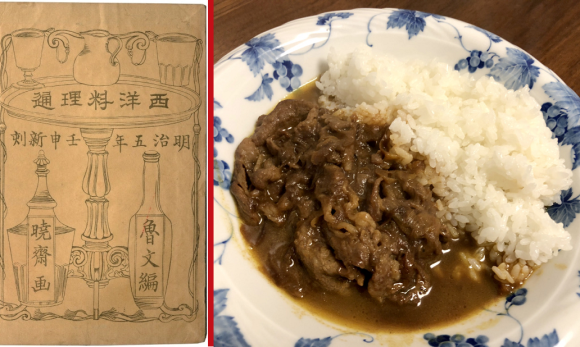Curry has become such a ubiquitous part of the Japanese diet that should you walk down a random street in Tokyo, you’re as likely to find a curry joint as you are a sushi or soba restaurant. That popularity has led to modern innovations such as matcha green tea and "Attack on Titan" curries, both of which we’ve happily eaten.
But today, instead of looking towards the future of Japanese curry, we’re turning our eyes to the past by making Japan’s oldest curry.

As popular as curry is in Japan now, it was entirely unknown until about 150 years ago. When Japan’s years of feudal-government isolationism ended in the late 19th century, it opened up the country not only to foreign science and technology, but foreign food as well.
Curry came to Japan through British sailors, who’d already made the originally Indian dish a staple of their at-sea cuisine. In 1872, the Japanese-language cookbook Western Cooking Michimasa-Second Volume was published, containing 110 recipes for the exotic meals and desserts eaten by foreigners who came to Japan.
Back here in 2018, we recently attended the Tokyo International Antiquarian Book Fair, where we got to look through a copy of the Meiji-period cookbook, which contained entries for:
● Curried Beef or Muten – Powder Sprinkled on Beer Technique
● Explanation of Curried Weel or Fowl Curry Bird Meat Cooked with Curry Powder
After a few moments deciphering the pre-standardized renderings of English loanwords (in modern Japanese, “curry” is written/pronounced カレー/kare, but the cookbook’s text has “curried” as コリード/koriido, for example), we realized we were looking at the two oldest recorded curry recipes in Japanese history, one for beef or mutton and the other for chicken. So we jotted down some notes and headed to the Sora Kitchen to cook, and eat, a bit of history.
Since the curry beef/mutton recipe was listed first in the book, we figured it has seniority on the chicken version, so that’s what we decided to make.
Ingredients (as listed in cookbook):
● Meat trimmings
● Spring onions (2)
● Bottor (4.5 loaves)
● Curry powder (1 shitoruto spoon)
● Flower (1 shitoruto spoon)
● Salt (a measure)
● Water or meat drippings
Ingredients we used:
● Beef (200 grams)
● Spring onions (2)
● Butter (150 grams)
● Curry powder (1 tablespoon)
● Flour (1 tablespoon)
● Salt (1 pinch)
● Water (150 milliliters)
Our entire staff was unable to figure out what a “shitoruto spoon” is or was, so we decided to use a tablespoon, under the logic that a teaspoon wouldn’t be enough curry powder to impart enough flavor. Should we ever build a time machine at some point in the future, we’ll be sure to go back and ask the book’s authors what they meant, then come back to the present and update the recipe seen in this article (but since that hasn’t happened yet, you can either assume time travel remains impossible or that we got distracted by something in the past, probably being able to meet real-life ninja).
With our ingredients assembled, it was time to look over the cookbook’s directions.
Directions (as listed in cookbook):
- Thinly slice the spring onions. Place them in a pot along with the bottor, and sauté until gray in color.
- Mix the shitoruto spoon of curry with the shitoruto of flour and salt, then add the mixture to the gray spring onions.
- Thinly slice the meat and place it in the pot. Mix it with the ingredients already there while cooking over a weak flame for 10 minyutes. Add the water or drippings, let simmer on a weak flame for half an hour.
At the risk of sounding arrogant, we’re going to assume that “cook the onions and butter until they’re gray” was either something that got lost in translation from the original British chef’s explanation, or maybe just an odd quirk of historical descriptions of color (maybe “gray-colored onions and butter” is just the cookbook author’s version of Greek poet Homer’s “wine-dark sea”). In any case, we’re not sure we’re talented/terrible enough cooks to get butter to turn gray anyway, so we made a slight change to that part of the recipe, but otherwise stuck to the cookbook’s plan, using a deep frying pan since it was large enough to hold our modestly-sized edible endeavor.
Directions we used:
- Slice onions, sauté with butter until golden.
- Mix curry powder, flour, and salt. Add mixture to onions and butter.
- Thinly slice beef and add to mixture. Sauté on low heat for 10 minutes.
- Add water, let simmer for 30 minutes.
When our curry was done, we poured it onto a plate with white rice occupying the other half, as is the Japanese serving style, and it actually looked pretty tasty, if you’ll forgive us for tooting our own horn.

Honestly, it didn’t look significantly different from modern curry. As for the taste……that’s a different story.
For starters, this old-school curry is much saltier than what you’ll find in contemporary Japan. There’s also a bit of bitterness, which we attribute to the onions getting slightly scorched when we tossed the curry powder and flour into the pan. Finally, there wasn’t a trace of the kid-pleasing sweetness found in modern Japanese curries.
Both of those might be problems that you could probably overcome, though. Being extra-slow and cautious when adding in the curry and flour should help prevent singing, and as for the saltiness, we’re guessing that perhaps the 19th-century British navy didn’t use salted butter like the kind we had in our 21st-century fridge, and an unsalted variety should improve the flavor balance quite a bit.
Still, Japan’s oldest curry has a unique charm all its own, and with the adjustments we mentioned, could be even better.
Read more stories from SoraNews24.
-- How to make your own Pikachu Burgers!【RocketKitchen】
-- No time to cook? No problem! Three easy ways to improve instant curry
-- Twitter user shares her cakey creation that looks just like a plate of curry rice
© SoraNews24 Take our user survey and make your voice heard.
Take our user survey and make your voice heard.




15 Comments
Login to comment
ozziedesigner
Nihon Curry = Gravy + Curry powder
afanofjapan
You can hear the British accent in the katakana words used here
Haruka
This recipe is actually very close to the recipe I got from a friend whose grandmother is the matriarch of one of the big Indian Restaurant names in Japan. The restaurants in those restaurants are made for the Japanese palette as well. Real Indian currie are much more soupy than the stuff made for Japanese people. (Go to an Indian's friend's house)
By the way, they could have fixed the onion issue with more oil and slower cooking while stirring more until the onions were not only translucent but eventually becoming buttery.
englisc aspyrgend
Wish I could come to dinner, sounds delicious! Can you get Mutton in Japan? The slightly stronger flavour complements the spices.
dcog9065
One of the best imports into Japan of all time. I’m so hungry now
englisc aspyrgend
Grey probably meant translucent. If this was adopted from a British navy recipe then you have to remember that to preserve food for long voyages salting was a common method (so yes salted butter), so the crew would have developed a taste for a higher salt content in their food than would be acceptable to a modern palate. There is a considerable difference between westernised "Curries" and Indian cuisine.
Interestingly the oldest known recipe for curry in English dates to Hannah Glasse in 1747, never tried making it but those that have say it comes out very similar to a Birmingham Balti, which was invented in the 1960's!
Toasted Heretic
I've not seen it in the supermarkets but some Indian curry houses have it on the menu. And yes, it's probably the best meat to go with the spices.
Toasted Heretic
I liked to do a curried udon from time to time.
GyGene
I've had curry all over Japan, Hokkaido to Okinawa and in between. I haven't eaten at EVERY curry place here, but the all time best was (sadly, past tense) Kikusui in Karuizawa in the 1970s to 1980s. If that place cooked it, everything they cooked, it was absolutely outstanding. A local place that closed when the chef retired...a true culinary loss.
Pukey2
Give me a vegetarian Indian or Thai curry any day (with basmati or jasmine rice).
Ah_so
"bottor" sounds best read in a sailor/pirate voice and you can almost hear the chef's voice and accent
englisc aspyrgend
"bottor" I would have said was more Ulster, think Ian Paisley?
starpunk
India curry is good in itself, and this curry in the pictures above are making me hungry too. Man, is that stuff really GOOD!